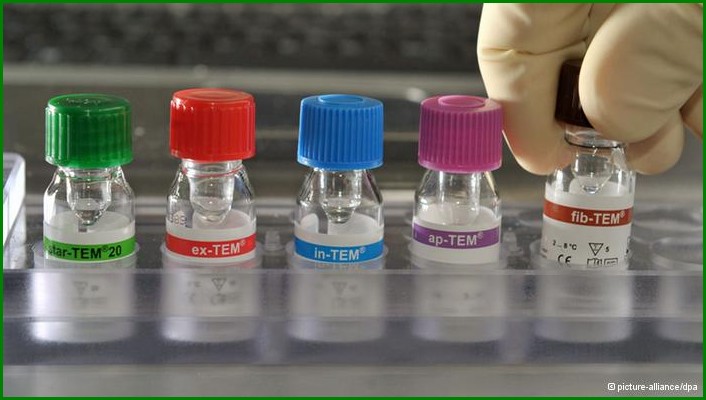Viral and bacterial infections require different treatment of viral and bacterial infections require different treatments, but to distinguish one from the other is not easy. Now scientists have proposed a new approach to solving this problem.

When a patient with obvious symptoms of acute respiratory infection and fever comes to the doctor, he must first of all establish what caused the infection - virus or bacterium. The answer to this question most directly affect the choice of effective medical therapy: for antiviral drugs are not suitable for the control of bacteria, and antibiotics are useless against viruses.
Until now, doctors have used for this purpose to a diagnostic laboratory tests to isolate and identify the causative agent of the particular disease.
Instead of finding the causative agent - the analysis of gene activity
Now a team of American scientists proposed a different approach to the problem. Epidemiologist Christopher Woods (Christopher Woods), a professor of the Faculty of Medicine at Duke University in Durham, North Carolina, explains former method of doing this kind of research was to identify the specific infectious agents. Of course, this gives the doctor valuable information, but such tests have two major drawbacks: first, they require a lot of time, and secondly, are only suitable for the detection of known pathogens.
Our new approach not based on the identification of pathogenic microorganisms, and on reception characteristics of the immune response of the human body to the infection.
The trick is, that the immune response caused by a bacterial infection, characterized by an immune response caused by a viral infection. Professor Woods and his colleagues have developed a technique that allows to detect these differences on the basis of the activity of several genes in white blood cells - white blood cells. We take a blood sample and isolate it from the laboratory of RNA - explains the scientist. - It allows us to measure the activity of genes.
We are interested in not all but only a well-defined genes, about which we know that they respond to a viral infection.
The average reliability of the rapid test - more than 90 percent
In their experiments, the researchers infected a group of 41 volunteer influenza virus subtypes and H3N2/Viskonsin H1N1/Brisben to trace the response of the immune system at the genetic level. Scientists were able to identify three dozen genes that are active in response to viral infection has increased dramatically. Bacterial infection is, however, on the activity of these genes had no effect, making it possible to select them as markers.
The researchers then conducted tests of their test on 102 patients who applied to the University Hospital emergency room complaining of flu-like symptoms and a high temperature. Rechecking the results of this new diagnosis by conventional diagnostic tests, researchers have seen in the high reliability of the genetic test: positive results were correct in 89 percent of cases, negative - in 94.protsentah.
Quick test as a means to combat antibiotic resistance
Test developers are hoping that its introduction into clinical practice will reduce the use of antibiotics. In the year that we record about 23 thousand deaths caused by pathogenic bacteria resistant to antibiotics - says Professor Woods. - A contributes to the development of resistance to this excessive use of antibiotics - sometimes they are given, even in situations where they are completely useless. We believe that our test will help your doctor to quickly find and distinguish bacterial infection that actually requires the use of antibiotics against viral infections, against which they are powerless.
This will reduce the evolutionary pressure on the bacteria, which is a consequence of the development of resistance.
Another important advantage of the new test is that it does not respond to the a particular virus, the immune response of the body caused by any virus infection. Thus, it is effective even if the disease is caused by some entirely new, unknown to science virus.
Save time by reducing the number of markers
Finally, a big advantage of the test is that it is able to detect the infection before it causes the typical clinical symptoms, even if the immune reaction occurs while seemingly unnoticed, it immediately causes a change in gene activity that is recorded and the test. This capability takes on a special value in the spread of a new pandemic virus, says Professor Woods: We will be able to know what the patient is already infected, and which have not yet, which is in urgent need of therapy and which may well wait.
So far, however, the test is not yet ready for use in clinical practice: the analysis takes 12 hours, and it is too long, especially in cases of emergency. However, the developers are hoping that in the next year or two, they can significantly reduce the duration of the analysis - primarily by reducing the number of analyzed markers. There is every reason to believe that the effectiveness of the test will not suffer if the activity is not limited to the measurement of all three dozen genes that appeared so far in the course of research, but only some of them.
This will save a lot of time.
Vladimir Fradkin
in the wake of dw.de
What is the difference between bacteria and viruses?
Both viruses and bacteria can cause infections. While these infections may feel similar, they are actually caused by different germs. It's important to know the difference between infections caused by bacteria and those caused by viruses. Antibiotics treat bacterial infections and won't work for viral infections. Using antibiotics to treat viral infections can lead to the development of antibiotic resistance.
Find out more about what a virus is at http://www.nps.org.au/conditions/comm...
Learn more about bacteria at http://www.nps.org.au/conditions/comm...